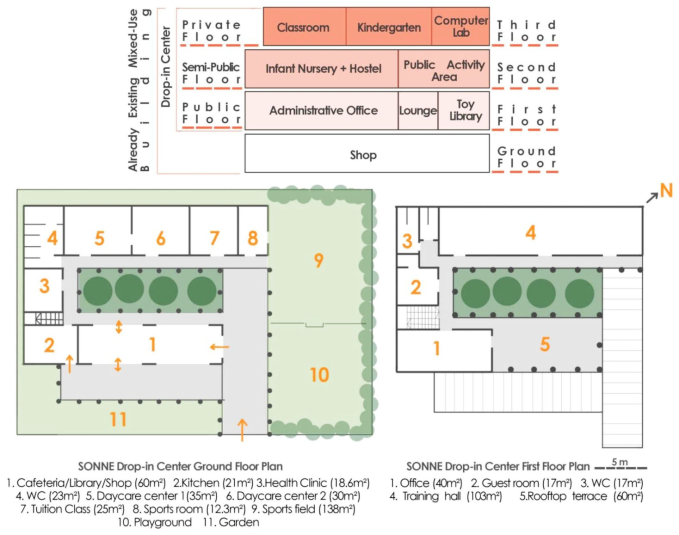
Journal of Contemporary Urban Affairs
2021, Volume 5, Number 2, pages 151– 168
Roles of Drop-in Centers in Street Children Interventions: Design Guidelines and Humanitarian Emergency Architecture Adaptations
* M.Sc. Ruba Azzam  , Dr. Karim Kesseiba
, Dr. Karim Kesseiba  , Dr. Ahmed Abdelghaffar
, Dr. Ahmed Abdelghaffar 
Dr. Mennat-Allah El Husseiny 
a, b, c and d Department of Architecture and Architectural Engineering and Building Technologies, Faculty of Engineering, Cairo University, Giza, Egypt
Email 1: ruba-azzam90@hotmail.com , Email 2: karimkesseiba@gmail.com , Email 3: amaghaffar@gmail.com
Email 4: mennatallahelhusseiny@gmail.com
ARTICLE INFO:
Received 9 July 2020
Accepted 3 September 2020
Available online 8 September 2020
Keywords:
Street Children;
Drop-in centers;
Child-Rehabilitation centers;
Architecture for Humanitarian Emergencies;
Child Friendly Spaces (CFS).
ABSTRACT 
For decades, numerous countries have been witnessing the Street Children phenomenon where millions of children worldwide are subjected to risks. Despite the crucial role of intermediate non-residential interventions - using drop-in centers- in protecting and rehabilitating street children, there is a paucity of research addressing the quality of design of these centers and how architecture might influence their operational process. Those observations invite investigating drop-in centers used in practice from a design perspective and question adapting architectural applications for humanitarian emergencies, focusing on “Child-Friendly Spaces”. The study aims to provide solutions for better quality design, facilitating operational challenges. The methodology undertakes the investigation through primary and secondary axes. This involves conducting literature and international precedents review and secondarily, an Egyptian contextual first-hand documentation and qualitative analysis of selected centers.
JOURNAL OF CONTEMPORARY URBAN AFFAIRS (2021), 5(2), 151-168.
https://doi.org/10.25034/ijcua.2021.v5n2-1
www.ijcua.com
Copyright © 2020 Ruba Azzam, Karim Kesseiba, Ahmed Abdelghaffar, Mennat-Allah El Husseiny.
1. Introduction
For well over three decades, numerous countries have been witnessing a phenomenon popularly known as The Street Children phenomenon. It is one involving tens of millions of children worldwide (Panter-Brick, 2002) with street relations subjecting them to various risks as physical abuse and depriving them of their rights (Aufseeser, 2017; Pare, 2003). An inspection of the phenomenon on the world map reveals early evidence of the phenomenon appears in the 1951 ''Street Children'' Egyptian film and reports by international organizations as the UNICEF documents estimates reaching 1 million children in Egypt; Egypt being no exception (Abt Enterprises LLC, 2001). The phenomenon is induced by various forces, some of which could be gradual as family dysfunction, while others could be sudden as the breakout of war (Aptekar, 1994, Rosenblatt, 2012). Given its many causes and the large fluctuating numbers of vulnerable children, this phenomenon can reach the level of a crisis (Ammar, 2009). The result is a need for non-punitive and gradual comprehensive intervention programs most suitable for protecting, rehabilitating, and reintegrating children into society (De Benitez, 2003; Dybicz, 2005; Nyamai & Waiganjo, 2014). Indeed, attaining these objectives has gained the interest of the research community who has long been developing intervention programs with several approaches (Figure 1) (Brink, 1997; Abt Enterprises LLC, 2001; Volpi, 2002; Rosenblatt, 2012).
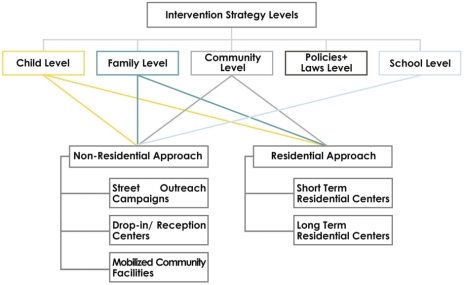
Figure 1. Intervention levels and approaches for street children phenomenon (Developed by Authors based on Azzam et al., 2019).
Analysis of such efforts indicates that comprehensive programs ideally consist of three stages: an initial street-outreach stage, an intermediate non-residential stage, and a final residential stage. Each stage requires corresponding structures to host children, rapid construction and operation, easy accessibility by children and flexible adaption to the phenomenon changing nature. However, despite the established vital role the intermediate non-residential stage - using drop-in centers- plays in the intervention (Volpi, 2002), an inspection of the phenomenon in literature reveals a scarcity and datedness in architectural contributions addressing the quality of design of these centers. This is accompanied by a focus on dated correctional and residential models unsuitable for the majority, which are the non-homeless children (Aptekar, 1994). Furthermore, there is a noticeable gap between what architectural research offers and operational challenges centers face in real life including economic limitations and children's constant mobility. Such observations- consequently- invite investigating drop-in centers used in practice from a design perspective and questioning adapting architectural applications for Humanitarian Emergencies (HE), particularly Child-Friendly Spaces (CFS) with similar desired properties, used during or in the aftermath of disasters (Kennedy et al., 2008).
Accordingly, this qualitative study showcases results of research aiming at providing solutions for better quality design of street children drop-in centers while responding to operational challenges. The adopted methodology investigates primary and secondary research axes. The former focuses on studying the street children phenomenon through a review of literature, observations of international precedents, and a first-hand contextual study of the phenomenon in the Egyptian ''Greater Cairo'' metropolis, where the largest concentrations of street children reside in Egypt. This is accompanied by a qualitative analysis of the design, operational process and challenges of selected drop-in centers operated by the Resala Foundation. The latter axis investigates CFS through reviewing international academic literature and precedents. The results of these axes enable assessing actual possibilities of adapting CFS to create efficient drop-in centers for street children while highlighting areas of improvement and- eventually- concluding a set of design guidelines for such centers in terms of technical, psycho-social, and administrative aspects concerning operation.
2. Drop-in Centers for Street Children: Objectives and Design Considerations in Literature
Irrespective of whether they are children living, working, or idly spending their day on the streets without adequate adult supervision (Panter-brick, 2002), drop-in - or reception- centers are safe spaces created to host all groups of streets connected children and those at risk of forming such connections. These centers aim at providing refuge for children from their daily street interactions. They represent an intermediate transitional stage between street existence and life back with the family or in the third-stage- residential centers that children can join of their own will. This is especially crucial since efforts leading the children too rapidly into environments with social constraints and different expectations of behaviour i.e., residential centers, may result in them feeling suddenly restricted or alienated and thus fail (Bibars, 1998). Accordingly, drop-in centers cater to children's non-residential needs and mitigate the increased risks of street connections to serve child-reintegration. The latter objectives are achieved through providing services meeting the children's immediate needs as personal care opportunities of bathing and washing their clothes, rest away from stressful street settings as well as healthcare and hot meals provision. Additionally, some centre-services have more preventive and rehabilitative purposes including recreational activities, sports, therapy sessions, family counselling, tutoring classes, and vocational training (Shillington et al., 2011) all of which make drop-in centers the foundation of actual rehabilitation.
To be easily accessible to the children and -possibly- their families, drop-in centers are usually located in urban centers or locations with high densities of the children. Consequently, the centers are usually in the form of rental apartment units in already existing buildings within the city as in the case of the Yayasan Chow Kit center in Malaysia or specially dedicated free-standing buildings as the future SONNE center in Myanmar (Aliaas et. al, 2012; SONNE Social Organization, personal communication via e-mail, 2018)- Figure 2. Such locations also facilitate the child-self-referral policy of most rehabilitative programs.
Identifying objectives, services, and possible set-ups of drop-in centers makes it possible to start exploring design guidelines in the literature that help create these spaces. However, despite extensive research of the phenomenon from socio-cultural and intervention-strategies perspectives (Dybicz, 2005; Ennew & Swart-Kruger, 2003), scarce and dated are the efforts discussing the design of non-residential spaces hosting street children. Yet, of particular significance is Brink's work in 1997 on design guidelines of centers for street children and AbdelRasheed’s work in 2004 on social welfare institutions for children at risk of delinquency, despite the latter's focus of residential facilities. Other beneficial efforts, which however do not directly target drop-in centers or street children, include work on the design of behavioral health facilities whose target population includes homeless youth and work on the design of day-care centers for children. In light of the previous work, design guidelines could be investigated through two complementary approaches: the traditional and humanitarian approaches discussed as follows (AbdelRasheed, 2004).
The former approach addresses technical and functional design aspects, which, in the case of drop-in centers hosting street-connected children, include the following:
-
a. Location: close to children's congregation nodes, easily accessible through walking or public transportation and away from pollution but within proximity to natural features and community services as public libraries and hospitals to encourage community interaction (Brink, 1997; AbdelRasheed, 2004; Moore & Sugyami, 2007)
-
b. Image: welcoming, child-friendly, and non-institutional image using single-story structures whenever possible, terraces, appropriate windows built to scale welcoming entryways and natural finishing materials while avoiding fences and security bars (Moore & Sugyami, 2007).
-
c. Capacity: low capacities to reduce anxiety and aggressive behaviour associated with crowdedness and allow for one-on-one interaction between specialists and children (AbdelRasheed, 2004).
-
Size and Modules: division of the center into a common core of shared facilities and several modules consisting of activity spaces and home bases i.e., spaces simulating home environments as dining halls, bedrooms, and baths, according to age groups and/or educational needs-see Figure 3 (Moore & Sugyami, 2007).
-
d. Spatial Program: center spatial program consists of : (i) a home base zone including separate napping areas for each gender with separate beds and bathroom facilities for each gender, a shared dining hall to bring children together for meals and activities, and locker space for children to keep their belongings, (ii) an activity zone including multipurpose and re-arrangeable areas for quiet and loud activities as reading and playing with toys respectively, (iii) a shared facilities zones as a reception area, kitchen, administrative offices, gyms, in-house clinic for attending to children's medical needs and group-therapy rooms, educational classes for literacy, formal education, and Non-Formal Educational (NFE) programs alongside vocational training workshops and (iv) an outdoor recreational zone to enhance children's' physical, social and emotional development through creative play using a variety of set-ups (Brink, 1997; AbdelRasheed, 2004).
-
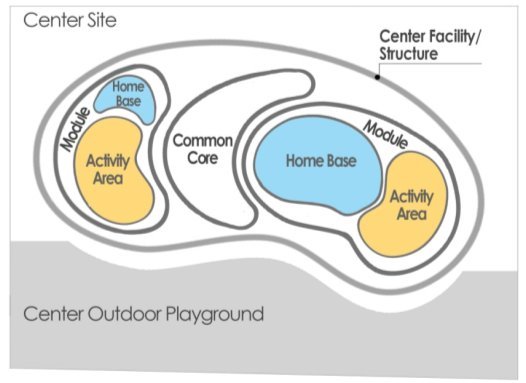
Figure 3. Module and zoning diagram for non-residential centers hosting children.
-
e. Spatial Properties: spaces should be (i) flexible and adaptable to encompass various activities and changing numbers of children using foldable furniture and partitions, (ii) physically well-defined for longer child-attention span using implied boundaries and semi-enclosed clusters achieved through furniture, changing levels, and changing finishing materials and (iii) visually spatially connected using low and transparent partitions (Moore, 1986; Brink, 1997; Shepley and Pasha, 2013).
-
f. Finishing Materials and Furniture: usage of easy to clean; safe and hygienic finishing materials as well as age-appropriate, flexible, and multi-purpose furniture items and layouts (Brink, 1997).
-
g. Environmental Quality Considerations: insurance of proper natural ventilation, natural lighting and acoustic levels not higher than 35 decibels using sound-absorbing finishing materials and furniture (AbdelRasheed, 2004).
The humanitarian approach, accompanying concepts of rehabilitative intervention, discusses the human dimension in the design process through two branches. The first branch is a line of design considerations responding to children’s psycho-social needs including giving them a sense of control and freedom of choice, familiarity to space, safety and security, privacy, and reduced negative emotions and stress. They help make the children more responsive to help and raise chances of intervention success. The second branch aims at facilitating facility operation through addressing administrative design requirements as to design for indirect supervision, clearly defined spatial boundaries and functions, and encouragement/discouragement of specific behaviors (Moore, 1986; AbdelRasheed, 2004; Shepley & Pasha, 2013). However, the previous review of design considerations for drop-in centers addressed in relevant literature reveals insufficient discussions of spatial rates, various architectural scenarios, and structure typologies to encompass the specified spatial program, considerations responding to the center operational challenges, as well as factors of time efficiency, cost, effectiveness and economic sustainability of used structures. These are the main requirements of intervention programs which are mostly run on tight and donation-based budgets.
3. Drop-in Centers in Greater Cairo: A Contextual Analysis
In an attempt to address the previously mentioned design gaps and further identify operational processes of and challenges facing drop-in centers, exploring what practice has to offer becomes crucial. The latter entails a first-hand contextual study of the phenomenon and drop-in centers in Egypt’s Greater Cairo, where the country’s largest number of documented street children reside. In addition to reviewing literature and legislations concerning the phenomenon in Egypt, the study relied on unstructured interviews with officials at the Egyptian Ministry of Social Solidarity, semi-structured interviews with 86.6% of the staff of three drop-in centers of Resala Foundation- a local Non-Governmental Organization (NGO)- (7 staff members) and 63.3% of the hosted children (22 children). Furthermore, qualitative analysis of three of the NGO drop-in centers, Maadi, Helwan, and Nasr City centers, were conducted.
This study further uncovers a shift in the perception of local Governmental Organizations (GO's) of street children from delinquents to being at risk since 2008 (Egyptian Ministry of Justice, 2008; Ammar, 2009). While the latter shift resulted in GO's adopting rather rehabilitative interventions- instead of the previous correctional ones- and incorporating street outreach campaigns into their process, GO efforts still lacked implementing the second intermediate stage using drop-in centers. Instead, local NGOs have historically adopted protective and rehabilitative interventions some of which using the 3-stage-comprehensive programs which incorporate drop-in centers (Azzam et al., 2019), an example of which is the locally active Aad Al Hayah (AAH) program run by Resala Foundation.
Since 2007, the AAH program has been operating intending to protect, rehabilitate and reintegrating both homeless and at-risk children, including children at risk of forming or already having street connections. Along with outreach campaigns and residential centers, the program second stage is conducted through 5 drop-in centers providing the largest coverage of Greater Cairo compared to other NGOs. Locations of the latter centers were selected based on the availability of space at the foundation branches while also working on covering reported nodes of children congregation on the streets. Once the child reaches the center through outreach campaigns or the child rescue hotline, for instance, the center rehabilitation process begins as follows:
a. reporting the child's case to the police department; b. creating a child's case file; c. conducting medical examinations of the child to identify illnesses/ injuries; d. identifying appropriate program for the child whether it is to visit the drop-in center or convince the child of moving to a residential center; and e. enrolling a child into the center-daily-activity program, including conducting family counseling sessions, to ensure child's protection and/or rehabilitation till child reintegration with family or referral to a residential center upon their consent. Selected AAH drop-in centers for this study are located in Maadi, Helwan and Nasr-City districts, since they represent different scales of the program centers- 95 m², 130 m² and 165 m² respectively- and the centers most regularly visited by children throughout the study. The three centers are located in mixed-use residential and commercial neighborhoods, which help to maintain a child-friendly and non-institutional center image and are easily accessed by children. They are also set-up in a readapted apartment unit consisting of a single module and a common core of shared facilities owned by Resala Foundation but not originally designed for their current purpose (Figures 4).
The study reveals that inspected centers rely on multi-functional spaces to facilitate the indirect supervision of hosted children, whose numbers could be uninspected (Figures 5,6,7). Additionally, they enable the provision of various services to children at the same time despite the center-limited space and given the economic and budget constraints facing such donations- dependent programs.
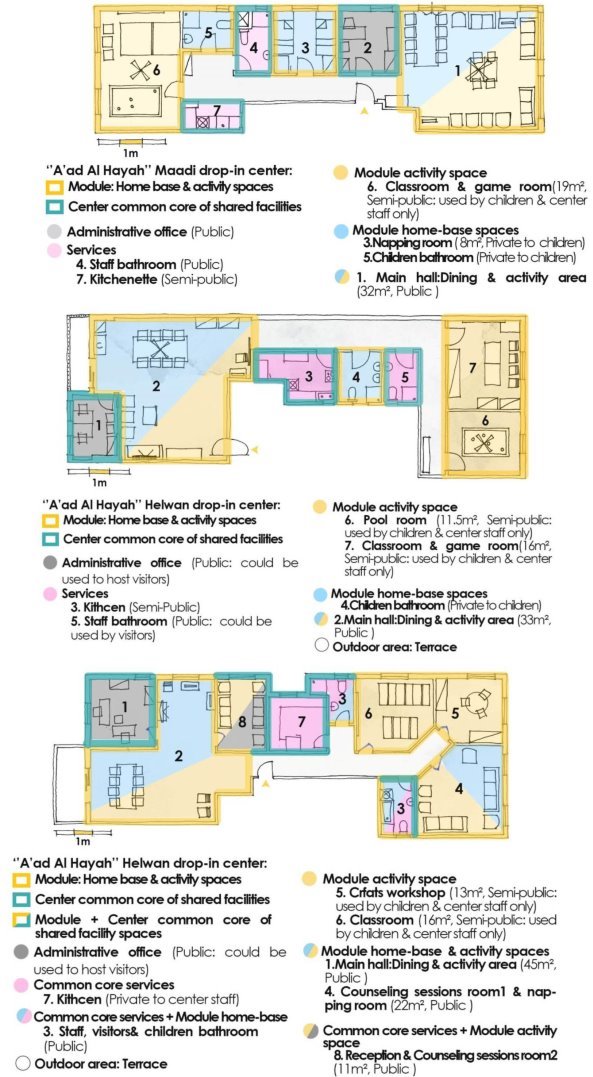
Figure 4. Top to bottom: AAH Maadi, Helwan, and Nasr City Drop-in Centers (Developed by Authors).
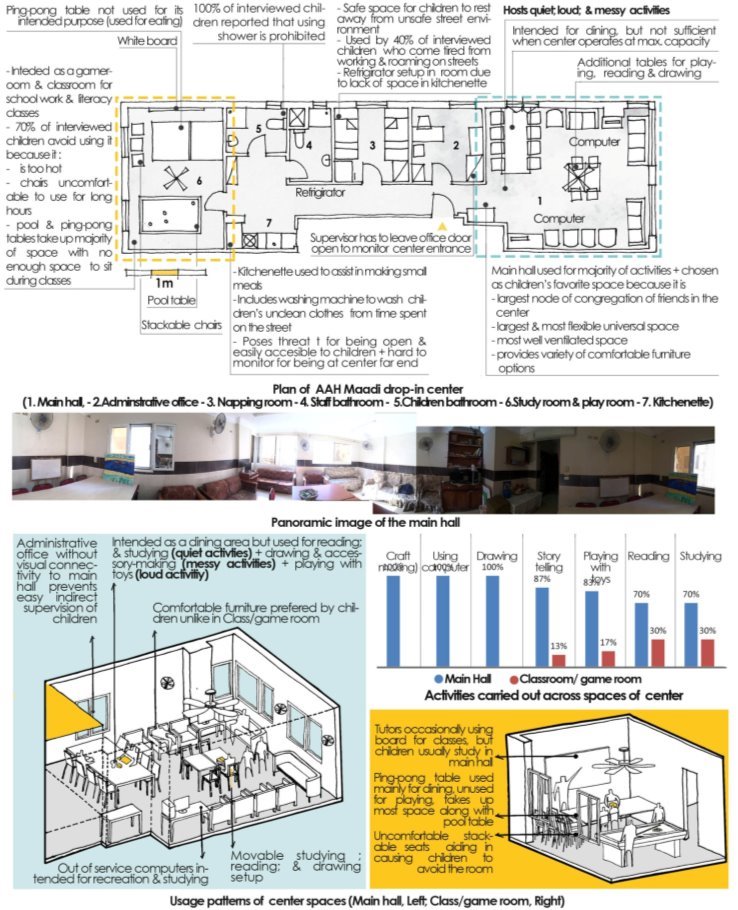
Figure 5. AAH Maadi drop-in center design and usage patterns (Developed by Authors).
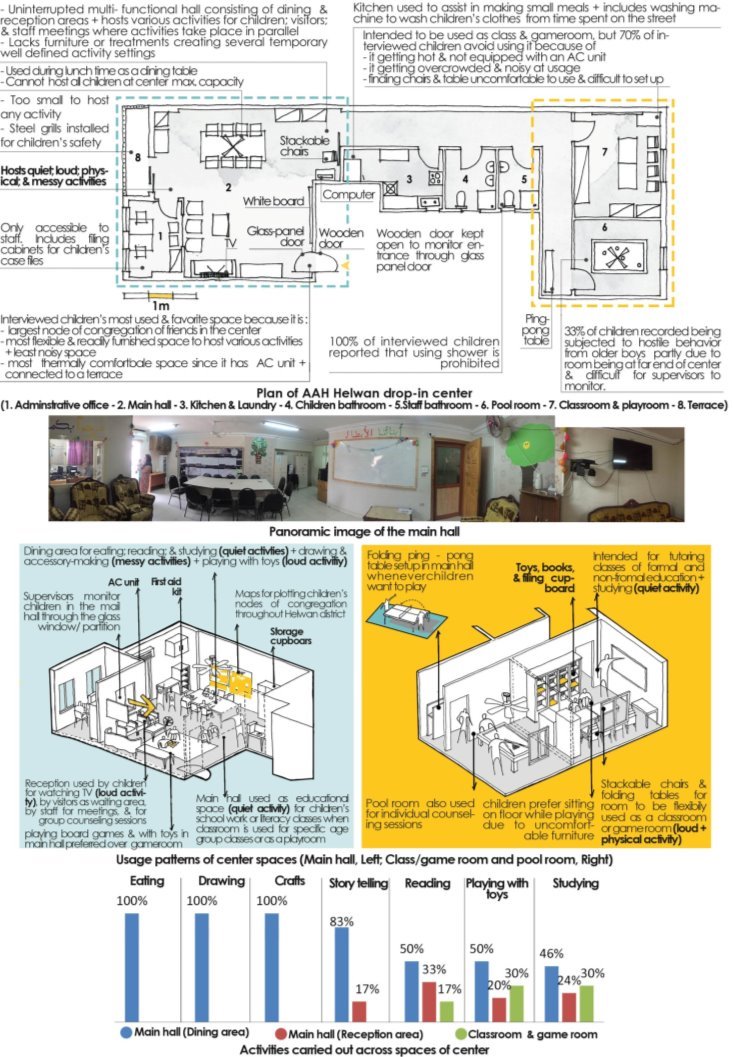
Figure 6. AAH Helwan drop-in center design and usage patterns (Developed by Authors).
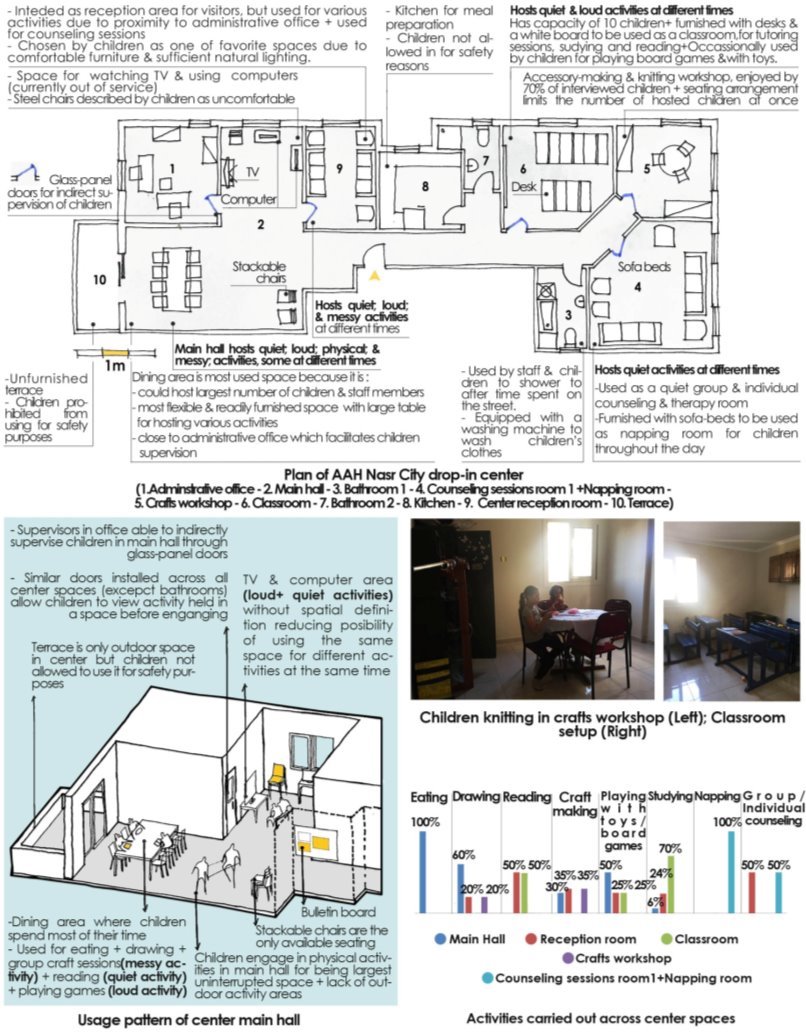
Figure 7. AAH Nasr City drop-in center design and usage patterns (Developed by Authors).
Based on the previous review of the AAH drop-in centers, utilized spatial programs and rates could be analysed as shown in Table 1.
Table 1. Standard rates analysis of utilized spaces in AAH drop-in centers.
|
Drop-in Center Location
|
Space
|
Space Rate
|
Standard Rate
(AbdelRasheed,2004)
|
Space Rate Status
(Above/Below/Within Standards)
|
|
Maadi District
(Center max. Capacity= 25 children)
|
A.1. Main Hall (As activity space)
|
1.28 m²/child
|
0.92-1.85 m²/child
|
Within
|
|
A.2. Main Hall (As dining hall)
|
1.28 m²/child
|
1.4 m²/child
|
Below
|
|
Napping room
|
2children/room
|
-
|
Violating
|
|
Children bathroom
|
1toilet
|
5toilets
|
Below
|
|
1sink
|
8sinks
|
|
1shower
|
3showers
|
|
Classroom & game room
|
0.76 m²/child
|
2.8 m²/child
|
Below
|
|
Helwan District
(Center max. Capacity= 35 children)
|
A.1. Main Hall (As activity space)
|
0.94 m²/child
|
0.92-1.85 m²/child
|
Within
|
|
A.2. Main Hall (As dining hall)
|
0.94 m²/child
|
1.4 m²/child
|
Below
|
|
B.1. Classroom & game room (As classroom)
|
0.45 m²/child
|
2.8 m²/child
|
Below
|
|
B.2. Classroom & game room (As game room)
|
0.45 m²/child
|
0.92-1.85 m²/child
|
Below
|
|
Children bathroom
|
1toilet
|
7toilets
|
Below
|
|
2sinks
|
12sinks
|
|
1shower
|
4showers
|
|
Nasr City drop-in center
(Center max. capacity=
30 children)
|
A.1. Main Hall (As activity space)
|
1.3 m²/child
|
0.92-1.85 m²/child
|
Within
|
|
A.2. Main Hall (As dining hall)
|
1.3 m²/child
|
1.4 m²/child
|
Below
|
|
B.1. Counseling room1+napping room (as counseling room)
|
2 children/room
|
_
|
Violating
|
|
B.2. Counseling room1+napping room (as napping room)
|
11 m²/child
|
_
|
_
|
|
Classroom (10 children capacity)
|
1.6 m²/child
(2children/desk)
|
2.8 m²/child
|
Below
|
|
Crafts room (3 children capacity)
|
4.3 m²/child
|
_
|
_
|
|
Children bathroom
|
2toilets
|
6toilets
|
Below
|
|
2sinks
|
10sinks
|
|
2shower2
|
3showers
|
|
Notes:
-
Napping rooms should generally not host only 2 children at once
-
Standard rates referenced in table are of residential facilities hosting children. They are only used in this analysis as a general comparison reference point.
|
|
|
|
|
|
|
While the latter tables highlight numerous missing spaces in the AAH centers, mainly due to limited center space and resources, centers rely on surrounding public and community facilities to provide such services. However, this did not stop playgrounds from being the most requested space to be added by interviewed children (64%) given their role in allowing for creative play and child NFE. Another major challenge facing the centers is their inability to adequately cope with the fluctuating numbers of hosted children. For instance, on days with high capacities (more than 25 children) the Maadi center is unable to host all the children due to limited and un-expandable spaces, while many of the center spaces remain unutilized during periods of low capacity as in the case of the Nasr City center for the past 5 years. Finally, since 100% of the hosted populations by Helwan center in 2018 were street-connected children who live 30 minutes away from the center, dedicated buses are readily available for a daily pick up to and from the center. This situation highlights issues arising with using fixed structures for drop-in centers and their inability to cope with the children's changing nodes of the congregation or varying origins along the years. The other challenges, the latter are echoed in GO's preparing proposals for using mobile units of readapted vehicles to provide accessible protective- rehabilitative services to at-risk and street children across various specified nodes in Greater Cairo. In this sense, identified design gaps and challenges deduced from the phenomenon literature and contextual study make it possible to proceed to the secondary axis investigating CFS's targeting children during humanitarian emergencies.
4. CFS's During Humanitarian Emergencies: Design Considerations and Properties
Undeniably, the extant global condition shows a humanitarian crisis with skyrocketing numbers of displaced people (UNHCR, 2019). Such realities caused by various economic, environmental, political, and healthcare-related forces have created affected populations in urgent need of aid necessary for their survival and rehabilitation (Brès, 1986; Jensen, 1996). In response to these, governments and aid organizations have long provided humanitarian aid hosted in specially designed structures and spaces, creating an architectural field famously known as Emergency Architecture or Architecture for Humanitarian Emergencies (HE) (Dorent, 2011; Lobos, 2011). There are several architectural applications for HE, yet those specifically designed to cater to the millions of children affected by disasters yearly are CFS's (Ager et. al, 2013). They are safe spaces devised and operated to provide children with thorough healthcare, psychosocial support, educational, and recreational programs in situations of armed conflict, natural disasters, or protracted crises as child labour (Davis & Iltus, 2008; IFRCS, 2017).
When it comes to their design, CFS's have three structure/ setting typologies: (a) fixed/ permanent settings as CFS in already existing community centers or schools; (b) temporary settings as emergency shelter-like structures attached to fixed or temporary settings similar to the CFS in Emirdağ tent city in Turkey following the 1999 earthquake; and (c) mobile settings as the UNICEF mobile CFS for Syrian children refugees in Turkey (UNICEF and University of Pitsburg, 2004; IFRCS, 2017; Lorch, 2017; Azzam et. al; 2019) (Figure 8). The latter typology is of significant importance given its ability to more easily and efficiently reach affected children in difficult-to-access locations due to geography or political sensitivities and provide them with rehabilitative services.
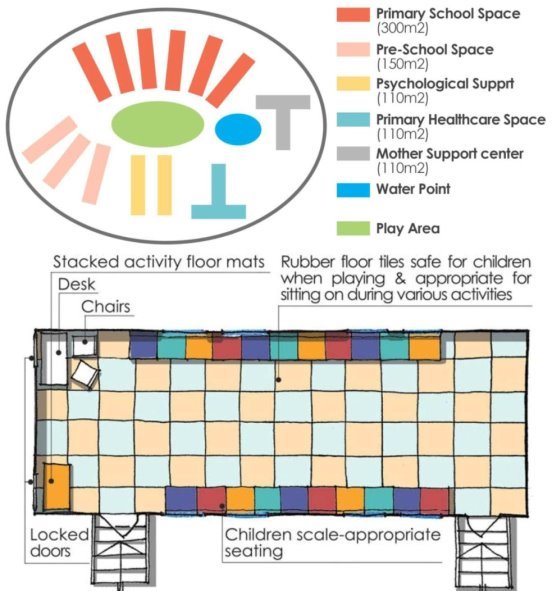
Figure 8. Top: Temporary CFS in Emirdağ tent city (Developed by Author based on UNICEF and University of Pitsburg, 2004), Bottom: UNICEF truck-based mobile CFS in Turkey (Developed by Author in Azzam et al., 2019).
To provide the intended services, CFS's should operate at a maximum capacity of 125 children per CFS/shift in case of non-mobile CFS's. Moreover, they should include, but not be limited to, the following spaces (Davis & Iltus, 2008):
-
Recreational Facilities: Safe multifunctional indoor and outdoor spaces supporting physical, intellectual, and social development of various age groups.
-
Medical Facilities: Private spaces for treatment from injuries, minor illnesses, and counselling
-
Toilets: Separate facilities for both genders and adult staff
For CFS's to achieve their role, research efforts and aid organization manuals have highlighted several properties. For instance, such spaces should be characterized by including multi-functionality, rapid construction, spatial flexibility, adaptability to different contexts, and scalability to cater to changing numbers of children. Furthermore, CFS's should have low construction and operational costs and provide rapid and easy access to target populations possibly through relatability via mobility or portability (Davis & Iltus, 2008; IFRCS, 2017).
5. Intersections between Street Children Drop-in Centers and CFS's
Based on the literature review of the primary and secondary study axes, the contextual study of drop-in centersand the reviewed international precedents, several areas of intersections on four different levels could be deduced between the architectural applications of both axes. The first intersection level focuses on target populations since applications of both axes target vulnerable children in need of protection and rehabilitation. Additionally, CFS’s target children in protracted crises as working children. This indicates the suitability of CFS's in catering to street children.
The second level is that provided services for drop-in centers provide protective and rehabilitative services very much similar to those of CFS’s.
The third is the level of spatial properties, which architectural applications should meet. Several similarities could be drawn between the identified spatial requirements of drop-in centers and CFS as they are both being flexible, adaptable, quick in construction and operation, low cost, user friendly, age-appropriate, multi-functional, community involving and easy to reach. Moreover, there are several identified missing properties from drop-in centers, despite them being crucial for more efficient performance as the study revealed and which are found in CFS's. Such design properties include structures being relocatable through mobility and/or portability, which as in the case of mobile CFS's, can help the centers address challenges of not being able to cope with street children's changing nodes of the congregation. Other properties include drop-in centers structures being temporary and expandable.
Finally, the fourth level is of the architectural typology where the study reveals that both drop-in centers and CFS's could be created in adaptively reused permanent/ fixed settings. However, given the established un-sustainability and inflexibility of fixed structures as well as benefits of the property of relocatability, creating mobile/ portable drop-in centers, which might be vehicle-based, can provide more accessible and efficient intervention solutions.
6. Street Children Drop-in Centers: Design Guidelines, Areas of Improvement, and adaptations of CFS Concepts
The previously conducted study of the primary axis of the street children phenomenon helps deduce that intermediate-stage interventions using drop-in centers, whether based in readapted facilities or specially designed, play a significant role in providing transitional safe spaces for the protection and rehabilitation of the children. This is ensured through the popularity such centers have in related academic literature and their usage by both international NGO's and other local centers in Egypt. Furthermore, they play a vital role in introducing children to options of living off the streets. Nevertheless, fixed drop-in center settings require design improvements to address issues of inflexibility, limited space and un-sustainability due to difficulties in coping with children's changing origins and nodes of the congregation.
In this light, the contextual study, secondary research axis and previously discussed areas of intersection all result in suggesting the usage of mobile/ portable, temporary and possibly modular structures for drop-in centers. This is because structures of such nature can easily expand when needed through the use of multiple units, and when there is no need for additional space the units could be moved to serve other locations. Moreover, previous issues could be addressed through using already existing community facilities like schools, parking lots and vacant land to set up drop-in centers according to pre-set schedules and day shifts. These previous suggestions are also backed up by international practice, where NFE and recreational services are provided in relocatable structures to vulnerable children as in the case of the UNICEF mobile CFS in Turkey. Additionally, interviewed intervention-program staff requires flexible and mobile solutions for easy reach of children at different locations. Eventually, these revelations along with the study axes as well as Greater Cairo's contextual analysis enable this study to formulate considerations to improve the design and operation of drop-in centers for street connected children. The considerations, in Table 2, are classified into technical, psycho-social and administrative aspects, in which case, properly applied technical aspects guarantees realizing the latter two.
Table 2. Design guidelines and considerations for street children drop-in centers.
|
Design Guidelines and Considerations
|
2nd Intervention Stage: Drop-in Center Stage
|
|
1.Location of used Structure
|
1.1. Technical
|
1.1.1. Nodes throughout city close to children's congregation nodes; community facilities; transportation nodes
|
|
1.2. Psycho-social
|
1.2.1. Giving children a sense of control and possibility of self-referral, avoiding isolation from the community
|
|
1.3. Administrative
|
N/A
|
|
2.Facility Image
|
2.1. Technical
|
2.1.1. Creating non-Institutional, child-friendly image using single-story structures whenever possible; verandas; scale appropriate windows; welcoming entryways; and natural finishing materials as stones instead of concrete blocks or large glass surfaces
|
|
2.1.2. Allowing children to view activities from outside through glass windows
|
|
2.2. Psycho-social
|
2.2.1. Creating a sense of familiarity; safety; and control
|
|
2.3. Administrative
|
N/A
|
|
3.Facility Capacity
|
3.1. Technical
|
3.1.1. Unspecified due to fluctuating numbers of hosted children per day, but low capacities preferred (min.7-11 children/unit, max. 21-30 children/unit)
|
|
3.2. Psycho-social
|
3.2.1. Avoiding over-crowdedness and high noise levels inducing stress; aggressive behaviours; and anxiety
|
|
3.3. Administrative
|
3.3.1. Facilitating supervision of children and management of the facility, enabling the provision of care to each child
|
|
4.Size and Modules
|
4.1. Technical
|
4.1.1. Using several modules in cases of centre hosting different age groups and/ or large numbers of children
|
|
4.1.2. Classifying some activity spaces, especially classrooms and educational spaces, according to educational level
|
|
4.2. Psycho-social
|
4.2.1. Allowing socialization and building friendships, avoiding institutional stressful environments resulting from over-crowdedness
|
|
4.3. Administrative
|
4.3.1. Facilitating supervision of children and management of the facility, enabling the provision of care to each individual child and establishing relationships with children
|
|
5.Zoning and Spatial Program
|
5.1. Technical
|
5.1.1. Home bases: napping rooms, dining area, children bathrooms (both genders in 2nd stage), separate locker area grouped in a zone
|
|
5.1.2. Activity areas: quiet activity areas as reading; studying; computer halls + loud activity areas as TV, music, and toy/playroom; drama theatre; arts and crafts room grouped in a zone
|
|
5.1.3. Common core of shared facilities: administrative offices, staff meeting rooms, visitors reception area, staff bathrooms, central kitchen, in-house clinic, vocational training workshops, gym, storage
|
|
5.1.4. Outdoor areas: playground or accessible roofs providing a variety of activities and socialization and creative play options
|
|
5.2. Psycho-social
|
5.2.1. Elements of the spatial program and categorizing spaces into private, semi-private, semi-public and public give children a sense of privacy, builds concepts of sharing and friendships
|
|
5.3. Administrative
|
5.3.1. Clear spatial functional definition, property boundary, and categorization of spaces facilitate running facilities by determining the responsibility of spaces among children.
|
|
6.Spatial Properties
|
6.1. Technical
|
6.1.1. Flexibility and adaptability: Avoiding permanent walls and using movable partitions, square-shaped rooms, and using foldable; modular; movable; and stackable furniture
|
|
6.1.2. Physical Spatial definition: Using partially surrounding partitions, transparent glass walls, low furniture, changing levels of floors or ceilings, creating implied boundaries through hangings; overhead lighting units; strong visual elements as posts; and changing floor covering/ texture, semi-enclosed spaces and clustering similar behavioural settings
|
|
6.1.3. Spatial Connectivity: Using partially surrounding partitions, transparent glass walls, low furniture items + avoiding placing spaces hosting children in isolation from other spaces
|
|
6.1.4. Multi-functioning: Including at least one multi-functional activity space to host various activities and a large percentage of hosted capacity, making use of properties and techniques of previous points 6.1.1., 6.1.2., and 6.1.3.
|
|
6.2. Psycho-social
|
6.2.1. Flexibility and adaptability: Allowing children to adjust spaces according to their needs, giving them a sense of control and ownership
|
|
6.2.2. Physical Spatial definition: Contributing to longer attention spans of children generating greater involvement in activity spaces
|
|
6.2.3. Spatial connectivity: Viewing activities in spaces before entering them providing a sense of personal choice to engage in them
|
|
6.2.4. Multi-functioning: Giving children of different age groups and backgrounds bigger opportunities to interact and bond over positive activities
|
|
6.3. Administrative
|
6.3.1. Flexibility and adaptability: Facilitating provision of several services to children in cases of space and resource limitations
|
|
6.3.2. Physical Spatial definition: Decreasing interruptions within spaces, providing a clear spatial functional definition
|
|
6.3.3. Spatial connectivity: Facilitating interaction with and supervision of children, avoiding un-favoured behavioural activities, and insuring safety and security of children
|
|
6.3.4. Multi-functioning: Facilitating interaction with and supervision of children
|
|
7.
Furniture and Architect-ural Elements
|
7.1. Technical
|
7.1.1. Using furniture items to provide previous spatial properties (see point 6.1.) , without sharp edges, age-appropriate, personal to each child in case of personal lockers + using covers for electrical outlets
|
|
7.2. Psycho-social
|
7.2.1. See points 6.1 and 6.2
|
|
7.2.2. Security of children: using furniture without sharp edges, furniture that is age appropriate, doors without locks and with glass panels to view spaces from outside, covers for electrical outlets
|
|
7.2.3. Sense of ownership, and belonging: using personal and age-appropriate furniture
|
|
7.3. Administrative
|
7.3.1. See points 6.1 and 6.4
|
|
8. Finishing Materials
|
8.1. Technical
|
8.1.1. Floors: Anti-slippery and easy to clean finishes especially inactivity and workshop areas, sound-absorbing finishes in loud activity areas as carpets and wood floors
|
|
8.1.2. Walls: Using easy to clean finishes in wet areas, sound-absorbing textured finishes and tiles in loud activity areas, washable paint, artwork that is cheerful and/or created by children
|
|
8.1.3. Ceilings: sound-absorbing finishes and tiles in loud activity areas, paint otherwise
|
|
8.2. Psycho-social
|
8.2.1. Creating calming settings and reducing anxiety and stresses by usage of cool-toned paint colors like blues and greens; cheerful soft artwork; sound-absorbing finishes
|
|
8.2.2. Creating a sense of privacy, belonging and ownership through hanging children's artwork, allowing them to change the wall colors and decorations
|
|
8.3. Administrative
|
8.3.1. Creating clear spatial functional and property boundaries definition and identification of responsibilities through usage of appropriate finishing materials according to activities hosted by spaces and allowing children to participate in the design of spaces
|
|
9. Indoor Environmental Quality
|
9.1. Technical
|
9.1.1. Ventilation and thermal comfort: Naturally ventilated spaces; proper building orientation, usage of effective-cross ventilation; high ceiling vents; aligned doors and windows, natural and mechanical ventilation in kitchens and bathrooms
|
|
9.1.2. Lighting: All spaces should be naturally and artificially lit
|
|
9.1.3. Acoustics: Sound level not exceeding 35 decibels + points 8.1.1.,8.1.2.,8.1.3.
|
|
9.2 Psycho-social
|
9.2.1 Reducing anxiety and creating positive attachments to spaces due to being comfortable
|
|
9.3. Administrative
|
N/A
|
|
|
|
|
7. Conclusions
Undeniable, there is a scarcity in architectural research addressing the design of drop-in centers hosting street-connected children during intermediate-stage interventions and how the design responds to challenges facing these centers during operation. Thus, investigating drop-in centers used in practice and the possibility of adapting design principles of CFS's can help create efficient solutions for this intervention stage, given the common need for rapid, flexible and easy to access responses. Indeed, this possibility itself became the study hypothesis which was asserted by intersections drawn between the structures of both study axes. As a result, the study can constitute a set of design considerations for drop-in centers, which would assist parties working with street children to create such structures and also serve as a documented baseline for future research and design improvements.
Despite the previous findings, the study encountered several limitations. Obtaining architectural documents on precedents of working street children was challenging given that the organizations approached for this refused sharing data for privacy policies, except for SONNE foundation, which shared drawings of their future center. Additionally, fully tracking changes in the Egyptian participating centers over the years according to the children’s needs and operational requirements was difficult due to frequent changes in staff members and lack of architectural documentation. Moreover, exclusive usage of secondary data sources of CFS's, - specifically mobile CFS was outside the research context. Lastly, evaluating the cost-effectiveness of the inspected center design was difficult due to the inability to obtain cost estimates of building and center operations.
Finally, these limitations pose opportunities for future research to explore interior design alterations to be introduced to existing drop-in centers to become expandable and adapt to constant changes in the number of hosted children. Specific to the Egyptian context, studies could focus on mapping vulnerable communities with children at risk of forming street connections, their needs and the possibility of introducing preventative permanent, temporary or mobile drop-in centers to suitable urban pockets and existing community facilities.
Acknowledgments
We would like to express our gratitude to the children and AAH program staff as well as SONNE Organization who participated in this study in partial fulfilment of a Master’s thesis carried out and supervised by the authors at Cairo University's Faculty of Engineering in Egypt.
Conflict of interests
The authors declare no conflict of interest.
References
AbdelRasheed, M. (2004). The Humane Aspects in The Design of Social Care Facilities for Juvenile Pre-Delinquency [Master's dissertation]. Faculty of Engineering, Cairo University, Giza, Egyp.
Abt Enterprises LLC. (2001). The situation of street children in Cairo and Alexandria, including the children's drug abuse and health/nutritional status. Rapid Situation Assessment Report, UNICEF, Cairo.
Ager, A., Metzler, J., Vojta, M., & Savage, K. (2013). Child friendly spaces: a systematic review of the current evidence base on outcomes and impact. Intervention, 11 (2), 133-147. http://dx.doi.org/10.1097/01.WTF.0000431120.01602.e2
Aliaas, M., Bajunid, A., & Abdullah, R. (2012). The Forgotten Children: Street Children of Chow Kit – An Architectural Odyssey. Social and Behavioral Sciences, 36 (1), 314-323. https://doi.org/10.1016/j.sbspro.2012.03.035
Ammar, N. H. (2009). The Relationship Between Street Children and The Justice System in Egypt. International Journal of Offender Therapy and Comparative Criminology, 53 (5), 556-573. https://doi.org/10.1177/0306624X08320209
Aptekar, L. (1994). Street children in the developing world: A review of their condition. Cross-Cultural Research, 28 (3), 195-224. https://doi.org/10.1177/106939719402800301
Aufseeser, D. (2017). Street Children and Everyday Violence. In Skelton,T., Harker, C., & Hörschelmann, K. (Eds.), Conflict, Violence, and Peace Geographies of Children and Young People, 109-127. Springer, Singapore. https://doi.org/10.1007/978-981-287-038-4_31
Azzam, R., AbdelGhaffar, A., Kesseiba, K., & ElHusseiny, M. A. (2019). Adapting Humanitarian Emergency Architecture for Street Children Outreach Campaigns. AGATHÓN | International Journal of Architecture, Art and Design, 6(online), 200-209. https://doi.org/10.19229/2464-9309/6192019
Bibars, I. (1998). Street children in Egypt: from the home to the street to inappropriate corrective institutions. Environment and Urbanization, 10 (1), 201-216. https://doi.org/10.1177/095624789801000108
Brès, P. (1986). Public Health Action in Emergencies Caused by Epidemics – A practical guide. Geneva, World Health Organization.
Brink, B. (1997). Guidelines for The Design of Centers for Street Children. Paris, UNESCO. https://unesdoc.unesco.org/ark:/48223/pf0000109106
De Benitez, S. T. (2003). Reactive, Protective and Rights-Based Approaches in Work with Homeless Street Youth. in Children, Youth and Environments, 13 (1), 134-149. https://www.jstor.org/stable/10.7721/chilyoutenvi.13.1.0134
Davis, K., & Iltus, S. (2008). A Practical Guide for Developing Child Friendly Spaces. UNICEF.
Dorent, N. (2011). Transitory Cities: Emergency architecture and the challenge of climate change. Development, 54 (3), 345-351. https://doi.org/10.1057/dev.2011.60
Dybicz, P. (2005). Interventions for street children: An analysis of current best practices. International Social Work, 48 (6), 763-771. https://doi.org/10.1177/0020872805057083
Egyptian Ministry of Justice. (2008). The National Council for Childhood and Motherhood: Egyptian Child Law no.12 for 1996, amended by Law no. 126 for 2008. Egypt. www.nccm-egypt.org/e7/e2498/e2691/infoboxContent2692/ChildLawno126english_eng.pdf
Ennew, J., & Swart-Kruger, J. (2003). Introduction: Homes, Places and Spaces in the Construction of Street Children and Street Youth. Children, Youth and Environments, 13(1), 81-104. https://www.jstor.org/stable/10.7721/chilyoutenvi.13.1.0081
IFRCS (2017). Child Friendly Spaces in emergencies – Lessons Learned Review. Geneva: International Federation of Red Cross and Red Crescent Societies. media.ifrc.org/ifrc/wp-content/uploads/sites/5/2017/05/IFRC-CFS-Lessons-Learned-Report-2017.pdf
Jensen, E. (1996). Introduction and Overview: Typology and Causes of Emergency Settlement. In in Schramm, D. and Thompson, P. (Eds.), New Approaches to New Realities: first international emergency settlement conference (pp. 2-15). Wisconsin, MA: University of Wisconsin Disaster Management Center.
Kennedy, J., Ashmore, J., Babister, E., & Kelman, I. (2008). The Meaning of ‘Build Back Better’: Evidence from Post Tsunami Aceh and Sri Lanka. Journal of Contingencies and Crisis Management, 16 (1), 24-36. https://doi.org/10.1111/j.1468-5973.2008.00529.x
Lobos, J. (2011). Architecture for humanitarian emergencies. Department of Conservation, School of Architecture, The Royal Danish Academy of Fine Arts, Denmark.
Lorch, D. (2017). In Turkey – Mobile child-friendly spaces bridge gaps between Syrian and Turkish children.www.unicef.org/infobycountry/Turkey_98464.html
Moore, G. (1986). Effects of spatial definition of behavior settings on children’s behavior: A quasi-experimental field study. Journal of Environmental Psychology, 6(3), 205-231. https://doi.org/10.1016/S0272-4944(86)80023-8
Moore, G., & Sugyamai, T. (2007). The children's physical environment rating scale (CPERS5): Reliability and Validity for Assessing the Physical Environment of Early Childhood Educational Facilities. Children, Youth and Environments, 17 (4), 24-53.
Nyamai, S., & Waiganjo, M. (2014). Factors Influencing Performance of Children Homes and Rehabilitation Centers within Nakuru Municipality and its Environs, Kenya. International Journal of Economics, Finance and Management Sciences, 2 (6), 362-377. https://doi.org/10.11648/j.ijefm.20140206.19
Panter-Brick, C. (2002). Street Children, Human Rights, and Public Health: A Critique and Future Directions. Annual Review of Anthropology, 31 (1), 147-171. https://doi.org/10.1146/annurev.anthro.31.040402.085359
Pare, M. (2003). Why have street children disappeared? -The role of international human rights law in protecting vulnerable groups. The International Journal of Child's Rights, 11(1), 1-32. https://doi.org/10.1163/092755603322384001
Rosenblatt, F. (2012). A Youth Justice Approach to the Street Children Phenomenon in Brazil: A Critical Review. Youth Justice, 12(3), 229-244. https://doi.org/10.1177/1473225412461214
Shepley, M., & Pasha, S. (2013). Design research and behavioral health facilities. Concord, CA: The Center of Health Design.
Shillington, M., Bousman, C., & Clapp, A. (2011). Characteristics of homeless youth attending two different youth drop-in centers. Youth and society, 43(1), 28-43. https://doi.org/10.1177/0044118X09351277
UNHCR (2019). Global Trends: Forced Displacement in 2018. Geneva: UNHCR. https://www.unhcr.org/5d08d7ee7.pdf
UNICEF, & University of Pitsburg (2004). Child Friendly Spaces/Environments (CFS/E): An Integrated Services Response for Emergencies and Their Aftermath. https://reliefweb.int/sites/reliefweb.int/files/resources/FA1830A25B25810BC125757F0037FA8E-UNICEF_dec04.pdf
Volpi, E. (2002). Street Children: Promising Practices and Approaches. Washington, D.C: The World Bank.

Azzam, R., Kesseiba, K., Abdelghaffar, A., & El Husseiny, M. A. (2021). Roles of Drop-in Centers in Street Children Interventions: Design Guidelines and Humanitarian- Emergency- Architecture Adaptations. Journal of Contemporary Urban Affairs, 5(2), 151-168. https://doi.org/10.25034/ijcua.2021.v5n2-1
*Corresponding Author:
Department of Architecture and Architectural Engineering and Building Technologies, Faculty of Engineering, Cairo University, Giza, Egypt
Email address: ruba-azzam90@hotmail.com
This article is an open access
article distributed under the terms and conditions of the Creative Commons Attribution (CC BY) license

This article is published with open access at www.ijcua.com

![]() , Dr. Karim Kesseiba
, Dr. Karim Kesseiba ![]() , Dr. Ahmed Abdelghaffar
, Dr. Ahmed Abdelghaffar ![]()

